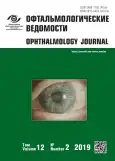Optical coherence tomogrpaphy in differential diagnosis of retinal arteriolar macroaneurysms
- 作者: Kulikov A.N.1, Maltsev D.S.1, Burnasheva M.A.1, Kazak A.A.1
-
隶属关系:
- Military medical academy of S.M. Kirov
- 期: 卷 12, 编号 2 (2019)
- 页面: 33-40
- 栏目: Original study articles
- URL: https://journals.rcsi.science/ov/article/view/11804
- DOI: https://doi.org/10.17816/OV2019233-40
- ID: 11804
如何引用文章
详细
Aim. To study the prevalence and topographical distribution of retinal exudation in eyes with retinal arteriolar macroaneurysms (RAM) and in those with macular branch retinal vein occlusions (mBRVO).
Methods. The prevalence of optical coherence tomography (OCT) signs (different types of retinal hemorrhages and accumulation of fluid as well as hard and soft exudates) was evaluated in 28 eyes with RAM (22 males, 6 females, mean age 66.0 ± 9.9 years) versus 17 eyes with mBRVO (9 males, 7 females, mean age 56.9 ± 10.5 years). Topographical distribution of retinal exudation on OCT retinal maps was evaluated in 7 RAM eyes (6 males, 1 female, mean age 66.0 ± 11.7 years) and 8 mBRVO eyes (5 males, 3 females, mean age 60.1 ± 19.2 years). The measures were 1) position of the point of the maximum retinal thickness in relation to the macular center and RAM, 2) difference between maximum retinal thickness in the macular center and that at the site of RAM localization (surrogate control point in mBRVO eyes).
Results. Soft exudates and intraretinal fluid accumulation were mostly associated with mBRVO (p = 0.007 and p < 0.001, respectively), while hard exudates were found almost exclusively in RAM eyes (p < 0.001). Central retinal thickness in RAM eyes was lower than that of mBRVO eyes, 453.1 ± 148.6 μm and 797.5 ± 179.6 μm, respectively (p = 0.001). The point of maximum retinal thickness was found at the site of RAM localization in 8 out of 9 RAM cases (88.9%), and within the central subfield in 8 out of 8 mBRVO cases (100%). The difference between maximum retinal thickness in the macular center and at the site of RAM localization (surrogate control point in mBRVO eyes) was –77.9 ± 174.1 μm and 148.3 ± 100.4 μm for RAM and mBRVO eyes, respectively (p < 0.001).
Conclusions. Evaluation of exudative signs and their topographic distribution based on OCT data may be used for differential diagnosis and laser treatment planning in RAM.
作者简介
Alexey Kulikov
Military medical academy of S.M. Kirov
Email: alexey.kulikov@mail.ru
MD, PhD, DMedSc, Professor, Head of the Department
俄罗斯联邦, Saint-PetersburgDmitrii Maltsev
Military medical academy of S.M. Kirov
编辑信件的主要联系方式.
Email: glaz.med@yandex.ru
ORCID iD: 0000-0001-6598-3982
MD, PhD, ophthalmologist of the Ophthalmology Department
Saint-PetersburgMaria Burnasheva
Military medical academy of S.M. Kirov
Email: maria.andreevna1@gmail.com
Ophthalmologist
俄罗斯联邦, Saint-PetersburgAlina Kazak
Military medical academy of S.M. Kirov
Email: ali-kazak@mail.ru
Student
俄罗斯联邦, Saint-Petersburg参考
- Brown DM, Sobol WM, Folk JC, Weingeist TA. Retinal arteriolar macroaneurysms: long-term visual outcome. Br J Ophthalmol. 1994;78(7):534-538. https://doi.org/10.1136/bjo.78.7.534.
- Terubayashi Y, Kida T, Fukumoto M, et al. Long-term follow-up case of multiple retinal arterial macroaneurysms developing branch retinal vein occlusion following ruptured macroaneurysm. Case Rep Ophthalmol. 2016;7(1):243-248. https://doi.org/10.1159/000445824.
- Strueven V, Schalenbourg A, Wolfensberger TJ. Multiple arterial macroaneurysms in acquired Coats’ disease in an adult – a case report. Klin Monbl Augenheilkd. 2015;232(4):583-584. https://doi.org/10.1055/s-0035-1545786.
- Moosavi RA, Fong KC, Chopdar A. Retinal artery macroaneurysms: clinical and fluorescein angiographic features in 34 patients. Eye (Lond). 2006;20(9):1011-1020. https://doi.org/10.1038/sj.eye.6702068.
- Papageorgiou E, Vasiliki D, Koufakis D. Multiple retinal arterial macroaneurysms associated with submacular hemorrhage. Eur J Ophthalmol. 2012;22(5):846-849. https://doi.org/10.5301/ejo.5000126.
- Yannuzzi LA, Rohrer KT, Tindel LJ, et al. Fluorescein Angiography Complication Survey. Ophthalmology. 1986;93(5):611-617. https://doi.org/10.1016/s0161-6420(86)33697-2.
- Butner RW, McPherson AR. Adverse reactions in intravenous fluorescein angiography. Ann Ophthalmol. 1983;15(11):1084-1086.
- Kwiterovich KA, Maguire MG, Murphy RP, et al. Frequency of adverse systemic reactions after fluorescein angiography. Ophthalmology. 1991;98(7):1139-1142. https://doi.org/10.1016/s0161-6420(91)32165-1.
- Hayreh SS, Zimmerman MB, Podhajsky P. Incidence of various types of retinal vein occlusion and their recurrence and demographic characteristics. Am J Ophthalmol. 1994;117(4):429-441. https://doi.org/10.1016/s0002-9394(14)70001-7.
- Bourhis A, Girmens JF, Boni S, et al. Imaging of macroaneurysms occurring during retinal vein occlusion and diabetic retinopathy by indocyanine green angiography and high resolution optical coherence tomography. Graefes Arch Clin Exp Ophthalmol. 2010;248(2): 161-166. https://doi.org/10.1007/s00417-009-1175-6.
- Laud K, El-Haig W, Yannuzzi LA. Optic nerve macroaneurysms as the initial presentation of idiopathic retinal vasculitis, aneurysms, and neuroretinitis. Retin Cases Brief Rep. 2008;2(1):41-43. https://doi.org/10.1097/01.icb.0000258960.61050.42.
- Magee MA, Kroll AJ, Lou PL, Ryan EA. Retinal capillary hemangiomas and von Hippel-Lindau disease. Semin Ophthalmol. 2009;21(3): 143-150. https://doi.org/10.1080/08820530500350712.
- Maddock IR, Moran A, Maher ER, et al. A genetic register for von Hippel-Lindau disease. J Med Genet. 1996;33(2):120-127. https://doi.org/10.1136/jmg.33.2.120.
- Maltsev DS, Kulikov AN, Uplanchiwar B, et al. Direct navigated laser photocoagulation as primary treatment for retinal arterial macroaneurysms. Int J Retina Vitreous. 2018;4(1). https://doi.org/10.1186/s40942-018-0133-z.
补充文件







